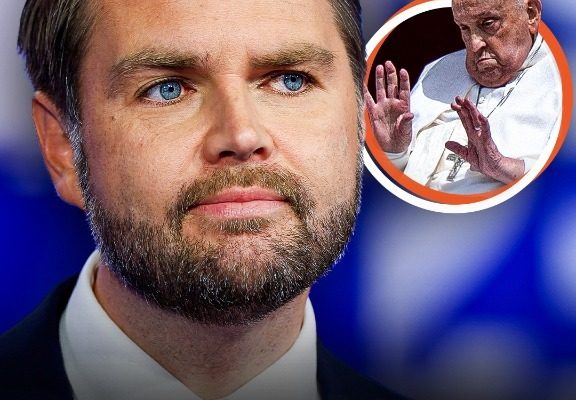JD Vance’s Sistine Chapel Photo Sparks Debate Over Vatican Protocol
A photograph capturing Vice President JD Vance and his young son gazing upward at Michelangelo’s ceiling in the Sistine Chapel has ignited a firestorm of online debate. Critics argue the image flagrantly disregards a century-old Vatican prohibition on photography within the chapel’s sacred walls. Supporters counter that prominent dignitaries often enjoy special privileges, pointing to past exceptions for visiting heads of state. Against the backdrop of Pope Francis’s final public engagements—culminating in a deeply personal meeting with the vice president just days before his passing—the episode raises questions about privilege, protocol and respect for religious tradition.
A Family Moment in a Sacred Space
On April 18, 2025, Vice President JD Vance, accompanied by his wife Usha and their three young children, visited St. Peter’s Basilica in Rome. Among the highlights of their Holy Week pilgrimage was a private viewing of the Sistine Chapel—arguably the crown jewel of the Vatican Museums. During that visit, White House photographer Emily Higgins captured a tender scene: Vance and his son standing side by side, heads tilted skyward as they admired the frescoed ceiling. The resulting photograph, later shared on social media by conservative commentator Charlie Kirk, projected warmth—a father sharing a moment of wonder with his child in the very heart of Christendom.
Yet what to many observers seemed an innocent family snapshot quickly morphed into a flashpoint. Within hours of Kirk’s post, countless users began flagging the image as evidence of a breach of longstanding Vatican rules: taking photographs inside the Sistine Chapel is strictly forbidden. As the post spread, comments ranged from incredulous (“They had signs everywhere saying no photos—how did this happen?”) to indignant (“Rules are rules, even for the vice president.”). Others speculated that Hollywood tour groups were routinely admonished by guards for snapping clandestine shots, while a high-ranking U.S. official appeared to enjoy carte blanche.
Vatican Restrictions Explained
Since the chapel opened to visitors in the late 18th century, the Vatican has imposed a firm no-photography policy. The prohibition serves multiple purposes: it preserves the solemn atmosphere, prevents flash-induced damage to fragile pigments, and underscores the chapel’s sanctity. According to the Museums’ visitor guidelines, “In the Sistine Chapel, it is forbidden to take photographs or films with any type of electronic equipment. Visitors who violate this rule may be asked to delete their images or to exit the chapel.”
Museum staff are explicitly empowered to confiscate or request the deletion of any illicitly captured images. Guards patrol discreetly, ready to intervene the moment a camera or smartphone comes into view. Signs both inside and outside the chapel reinforce the rule in multiple languages. Tour guides routinely stress the importance of silence and respectful behavior, reminding travelers that the chapel remains a place of prayer and pilgrimage, not a museum for endless photo-ops.
Despite these measures, the novelty and prestige of the Sistine Chapel draw millions of tourists each year—many of whom quietly defy the ban. Social media platforms are awash with grainy snippets of the Creation of Adam, and influencers often brag about slipping past the guards. Yet when a senior U.S. official appears to flout the ban, public reaction is markedly harsher, raising concerns about double standards.
Precedents for High-Level Exceptions
Observers pointing to history note that the Vatican has occasionally relaxed its rules for distinguished guests. In 2009, for instance, former First Lady Michelle Obama was photographed inside the chapel during a private tour with Pope Benedict XVI. That image, circulated by the White House, showed Mrs. Obama gazing upward at the frescoes—straightly parallel to the recent Vance photo. No reprimand or request for deletion followed.
Similarly, state visits by royalty or heads of state have sometimes included commemorative photographs in restricted areas. These exceptions are customarily negotiated in advance, often as part of the official protocol. When such dispensation is granted, Vatican officials typically oversee the arrangement, ensuring that any images released respect both the chapel’s dignity and the gravitas of the moment.
The decision to allow or deny photography rests with the Vatican Museums’ Director and the Prefect of the Papal Household, who liaise with visiting delegations. In recent years, opportunities for limited, pre-approved photography have been offered to foster goodwill and cultural diplomacy. Yet these arrangements are rarely publicized; they remain confidential footnotes in the annals of Vatican hospitality, not headlines.
Context: A Holy Week Pilgrimage
Vice President Vance’s April trip to Rome coincided with the pinnacle of the liturgical year. Good Friday, commemorating Christ’s Passion, draws tens of thousands of pilgrims to St. Peter’s Basilica and the adjacent square. Vance and his family attended a solemn service at the basilica on that day, joining cardinals, bishops and faithful from around the globe.
Accompanied by his wife Usha and their children Ewan, Vivek and Mirabel, the vice president embraced the opportunity to engage with Catholic traditions. Outside the chapel, he knelt in silent prayer, exchanging greetings with pilgrims and local clergy. Though wearing his customary suit rather than liturgical vestments, Vance was afforded the same courtesies extended to visiting dignitaries: a brief blessing with holy water, a guided tour through the nave, and reserved seating for the Passion liturgy.
Families at home watched intently as images of the vice president’s personal faith journey circulated online. Catholic opinion columnists weighed in, some praising his reverence, others questioning the prudence of blending a private faith pilgrimage with a public diplomatic itinerary. Yet it was the Sistine Chapel photograph that captured the spotlight.
The Final Public Exchange with Pope Francis
Just two days after the Good Friday service, on Easter Sunday (April 20), Vice President Vance was escorted to Casa Santa Marta—Pope Francis’s residence within Vatican walls. The timing was poignant: the pope’s health had been in steady decline following a protracted hospital stay for pneumonia, and his Easter appearance was widely seen as a farewell.
In a video later released by the Vatican, Vance is shown entering the modest sitting room. Pope Francis, seated in a wheelchair, greets him with a warm smile. Although the pontiff’s voice is soft and low, a priest translates his words into English, conveying the pope’s wishes for the vice president’s children. The pope then presents a small basket of chocolate eggs—an Easter tradition—and hands over rosaries and a Vatican-branded tie.
The vice president responds with a respectful bow, clasping the pope’s hand before posing for a brief photograph. In remarks to Vatican photographers, Vance expressed gratitude for the spiritual encounter and promised to honor the pope’s messages of compassion and service back in Washington. As he departed, Vance lingered momentarily at the doorway, offering a final blessing.
Pope Francis’s Declining Health and Passing
On April 21, the Vatican confirmed that Pope Francis had died at 7:35 a.m. at the age of 88. The official statement cited a cerebral stroke that led to irreversible circulatory collapse, following a protracted period of diminished strength after battling bilateral pneumonia in February. His final public blessing the previous day from the balcony of St. Peter’s Basilica proved to be his last.
Cardinal Kevin Farrell, acting as camerlengo, formally announced the pontiff’s death later that morning in a brief ceremony at Casa Santa Marta. “His entire life was dedicated to the service of the Lord and of His Church,” the cardinal intoned, calling upon the faithful to pray for the repose of Francis’s soul. Across St. Peter’s Square, pilgrims—many in tears—held rosaries aloft and recited the Divine Mercy chaplet in unison.
In the days that followed, thousands queued to pass before the pope’s coffin, displayed in the chapel adjacent to the basilica. Many left flowers, flags or handwritten messages. The Vatican Press Office outlined a schedule of Lenten devotions, requiem masses and the eventual conclave, during which the College of Cardinals would elect Francis’s successor.
Public Reaction to the Photographic Dispute
Against this backdrop of mourning, the controversy over Vance’s Sistine Chapel photograph simmered on social media. Some commentators accused the vice president of callous insensitivity—highlighting that while memorial services proceeded inside the chapel, a family snapshot had seemingly undermined the sacred atmosphere. “Once the funeral rites begin, the focus should be on prayer, not on who snapped a selfie,” wrote one online columnist.
Others defended Vance, noting that the photograph predated the pope’s passing and was taken under the supervision of Vatican authorities. “If guards didn’t intervene, they must have deemed it appropriate,” argued a news commentary program. Several diplomatic observers noted that state visits often include carefully choreographed photo opportunities, and that the Vatican had likely cleared this one in advance.
Traditionalist Catholics weighed in, lamenting what they see as a broader relaxation of decorum under recent popes. “The chapel should never be turned into a backdrop for political photo-ops,” opined the head of a Rome heritage society. Meanwhile, supporters of the vice president pointed out that his family’s genuine awe before centuries-old masterpieces humanizes a public figure often cast as distant and dour.
Political Implications and Partisan Responses
In Washington, the episode took on a partisan dimension. Republican allies lauded Vance’s expressions of personal faith, contrasting them with what they described as former administrations’ secular leanings. They argued that sharing private religious moments builds bridges with faith communities and underscores the administration’s roots in traditional values.
Democratic critics, however, seized on the incident as evidence of the vice president’s entitlement. They highlighted past controversies—such as exemptions from local campaign finance rules—and painted the Vatican photo as one more instance of preferential treatment. “When you’re above the rules that millions of tourists must follow, it betrays an arrogance unbecoming of a public servant,” charged a congressional spokesperson.
Amid the back-and-forth, the White House clarified that all elements of the trip, including the Sistine Chapel visit, were coordinated with Vatican protocol officers. A spokesperson emphasized that all official photographs had been vetted in advance, and that no unauthorized images were publicly disseminated by U.S. personnel.
Reflection on Tradition, Access, and Respect
The furor surrounding a single image reveals broader tensions at the intersection of diplomacy, religion and public perception. On one hand, the Vatican—as both spiritual center and cultural treasure trove—must balance preservation with hospitality. On the other, global leaders seek meaningful engagement with religious traditions, often in intimate settings that the public rarely glimpses.
For Vatican curators, the incident underscores the challenge of enforcing rules in an age of ubiquitous cameras. When security guards are outnumbered by smartphone-wielding pilgrims, the temptation to capture a once-in-a-lifetime view can override solemn pledges of silence. Yet high-profile breaches risk eroding the chapel’s sanctity and diluting the significance of its art.
For political figures, the episode offers a lesson in optics. Even personal or family moments—shared in good faith—can be scrutinized through a prism of privilege. When images circulate beyond their original scope, they assume symbolic weight, inviting debate about authority, access and exemption.
Conclusion
The controversy sparked by Vice President JD Vance’s Sistine Chapel photograph transcends a simple rule violation. It touches on questions of reverence, privilege and the evolving dynamics between public figures and private faith. As pilgrims continue to flock to Vatican City—many still unaware of the online uproar—the incident serves as a cautionary tale: in an era where every gesture is documented, even the most heartfelt moments must navigate the delicate balance between tradition and transparency.
In the end, Vance’s visit will be remembered not only for his final conversation with Pope Francis but also for the image that captured a son’s wonder and set off an international discussion about respect for one of the world’s most hallowed spaces. Whether viewed as a harmless family portrait or an overstep of diplomatic privilege, the episode will prompt ongoing reflection on how we honor sacred traditions in a connected age—and who gets to hold the camera.



